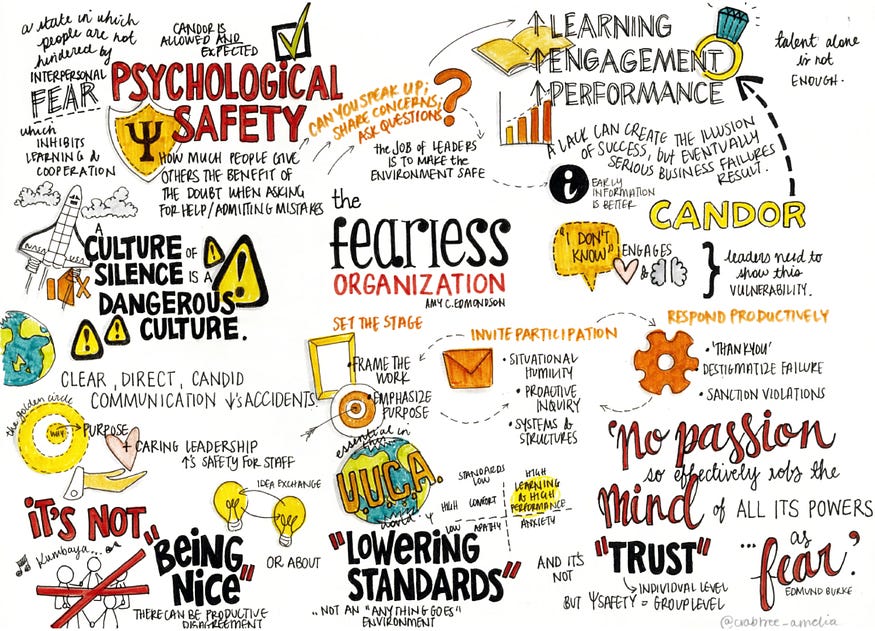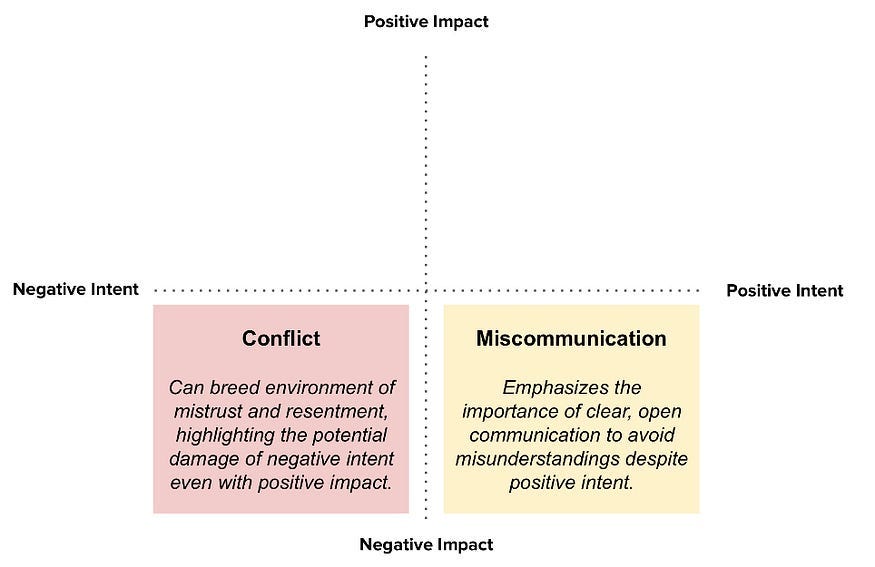Building High-Performance Teams: 4 Essential Leadership Principles
Throughout my career, I’ve always been driven by a deep passion for learning and a desire to share knowledge with others. In this post, I am excited to share four essential leadership principles that have significantly transformed my approach to team building and collaboration. I dive into each principle, dissecting what it is, why it matters, and its practical application in everyday scenarios.
Leadership transcends titles and roles. It’s an evolving mindset and skill set that is constantly refined throughout one’s career. With this post, I aim to provide not just theoretical knowledge, but actionable insights that can inspire and guide you on your own leadership journey. I’m hopeful that you can learn something new to add to your own leadership toolkit.
Cultivate Psychological Safety Within Teams
Psychological safety refers to an individual’s perception of the consequences of taking an interpersonal risk and plays a vital role in creating high-performing teams. Amy Edmondson’s research on this topic is a must-read for all leaders. In teams with high psychological safety, teammates feel safe to take risks around their team members. They feel confident that no one on the team will embarrass or punish them or anyone else for admitting a mistake, asking a question, offering a new idea, or delivering constructive feedback.
When psychological safety is absent within teams, it drives people into self-preservation mode which can stifle creativity, hinder problem-solving, and lead to decreased collaboration, innovation, and overall team performance. It can sometimes derail into a toxic, passive-aggressive culture that leads to high turnover. Google’s Project Aristotle unlocked a powerful realization that psychological safety was the #1 most important factor within high performing teams.
If your goal is to foster psychological safety within your team, here are some important concepts to consider. Keep in mind that transforming your team’s culture requires genuine and intentional effort, and might be challenging due to each of our individual histories, biases, and sensitivities. Treat this like a muscle that needs to be trained with consistency and nurture.
Destigmatize failure: Make it clear from the beginning that failure is acceptable and part of the learning process.
Embrace fallibility and humility: Acknowledge that you don’t have all the answers and actively encourage team members to contribute their ideas and expertise.
Respond constructively: Show gratitude for people’s contributions and incorporate their feedback into your team’s processes and decision-making.
By applying these principles, you can create an environment where team members feel safe to take risks, share their thoughts, and collectively work towards success. While promoting psychological safety, it is also important to not overextend towards a culture of complacency. High psychological safety must be balanced with high accountability for meeting demanding goals. The end result is a path to high performance.
“Psychological safety is not just a nice-to-have, it’s a must-have for teams to thrive. It’s the foundation that allows individuals to take risks, share ideas, and foster a culture of innovation.” — Amy Edmondson
Takeaway: Ask open-ended questions that encourage dialogue, exploration, and deeper understanding, allowing teams to express their thoughts, share insights, and actively contribute to the conversation.
Recommended Reading: “The Fearless Organization: Creating Psychological Safety in the Workplace for Learning, Innovation, and Growth” by Amy C. Edmondson (Link)
Assume Positive Intent for Better Collaboration
The disconnect between intent and impact underscores a critical phenomenon — our actions, regardless of the intentions behind them, can be interpreted differently by others. This disparity or miscommunication can emerge due to a multitude of factors, such as individual perspectives, inherent biases, or differences in cultural backgrounds.
The practice of assuming positive intent is a cornerstone of trust-building and open communication within teams. By fostering an atmosphere where we presume positive intentions, we take strides towards closing the gap between what was intended and how the actions were perceived. When negative impact occurs, our initial response becomes centered around miscommunication rather than conflict. This mindset fosters a supportive environment that encourages candid discussions and fruitful collaboration, propelling us towards alignment. Conversely, neglecting to assume positive intent can erode trust and hinder communication, ultimately impeding collaboration and stifling productivity.
If we default to conclusions around negative intent, over time we can start to act as if they are true. In situations with poor communication, we stop trusting others, we stop working with them on high-priority projects, and we ultimately cut ourselves off from them, as well as from their talents and skills. If not properly managed, it can lead to a culture of silos and missed opportunities for collaboration and innovation. Thankfully, this cycle can be broken with one simple cognitive shift: adopting a mindset of curiosity and striving to understand before rushing to judgment.
Hanlon’s Razor reminds us that some bad things happen not because people have bad intentions but because they didn’t think through it properly. I believe there is far more upside in life when you start every relationship at a point of trust (i.e. positive intent / trust is given by default) vs mistrust (i.e. positive intent / trust must be earned). Sure you’ll get burned a few times, but net-net it is way better for both sides. And you’ll be happier.
“Whatever anybody says or does, assume positive intent. You will be amazed at how your whole approach to a person or problem becomes very different. When you assume negative intent, you’re angry. If you take away that anger and assume positive intent, you will be amazed.” — Indra Nooyi, former Chairman and CEO of PepsiCo
Takeaway: Give people the benefit of the doubt. Assume that they had positive intentions, identify the situational details, and get the bigger picture.
Recommended Reading: “The Speed of Trust: The One Thing That Changes Everything” by Stephen M.R. Covey (Link)
Shift the Energy of Disagreement with Active Listening
Effective communication is not just about expressing our own opinions; it also involves active listening and understanding the perspectives of others. Have you ever witnessed a dialogue where two individuals were simply repeating their opinions without truly hearing each other? This approach often leads to escalating conflict and unproductive outcomes. When people feel unheard, they tend to respond with more force or give up entirely, neither of which helps resolve the disagreement.
When we attempt to communicate, we have two modes: sending and receiving. If both parties are in send mode, neither is listening and no actual communication is taking place. It is only when one party feels heard that they will listen to what the other party has to say. To ensure your point is heard, it’s essential to listen first and approach the conversation with curiosity. By doing so, you can create an environment that encourages dialogue and fosters progress towards a solution.
Here are four different phrases that you can use to foster effective communication, show understanding, and encourage dialogue:
“You might be right…” — De-escalates a situation by validating the other person’s viewpoint. It demonstrates your willingness to consider alternative perspectives.
“Help me understand why…” — Prompts the speaker to share more on their viewpoint, giving you more information and helping you empathize with their position.
“Could you elaborate more on that point?” — Signals your interest in their ideas and encourages them to share more about their thought process.
“I see where you’re coming from. Have you considered…?” — Shows respect for the perspective before gently introducing a new idea or different viewpoint.
By adopting this approach to communication, we can foster effective dialogue, deepen our relationships, and make meaningful progress. Adam Grant’s book “Think Again” emphasizes the importance of intellectual humility, which aligns with the mindset required for successful communication. There’s a lot we can learn when we seek to understand.
“Most people do not listen with the intent to understand; they listen with the intent to reply.” — Stephen R. Covey
Takeaway: Take ownership by listening and introducing the following phrases to shift the energy of the conversation towards a resolution: “You might be right” or “Help me understand why….”
Recommended Reading: “Think Again: The Power of Knowing What You Don’t Know” by Adam Grant (Link)
Focus On What You Can Control (And On What Matters)
The ability to focus on what you can control is transformative, empowering teams to navigate challenges and setbacks with more resilience and adaptability. Stoicism teaches us to detach ourselves from external outcomes and instead channel our energy towards what we can influence and what truly matters. By integrating Stoic principles into our approach, we cultivate resilience, make meaningful progress, and unlock our full potential for success.
Below are a few key principles to keep in mind when deciding how to allocate our time and resources. Consider the following guidelines:
Matters // Can Control? → Focus: By identifying what is within our sphere of influence, we can prioritize actions that align with both what we can control and what is truly important. This enables us to direct our energy towards tasks that have the greatest impact.
Matters // Can’t Control? → Understand: Acknowledge the factors that are important but lie outside of our direct control. While we may not have the power to influence these elements directly, we can develop an understanding of them and their impact on our goals. This understanding helps us adapt and make informed decisions.
Don’t Matter // Can Control? → Minimize: Recognize the areas where we have control but are not aligned with what truly matters. It is crucial to minimize our efforts and avoid wasting valuable resources on non-essential tasks. This allows us to optimize our productivity and focus on what truly drives meaningful outcomes.
Don’t Matter // Can’t Control? → Ignore: Recognize the areas that are both beyond our control and not important in the grand scheme. These distractions can consume our time and energy, diverting us from meaningful initiatives. By consciously disregarding them, we free up resources to focus on activities that truly contribute to our success.
By adopting a solution-oriented mindset and concentrating on what can be controlled, organizations can break free from a sense of helplessness that can often arise, channeling their energy instead toward actionable steps and meaningful progress. Cultivating a culture that values problem-solving and encourages team members to concentrate on controllable inputs fosters a sense of empowerment and drives progress.
“The more you focus on what you can control, the more control you’ll have.” — Yogi Berra, former professional baseball player and coach
Takeaway: Encourage individuals to identify both what they can control and tasks of consequence. Provide support, guidance, and resources to help individuals develop a solution-oriented mindset.
Recommended Reading: “The Daily Stoic: 366 Meditations on Wisdom, Perseverance, and the Art of Living” by Ryan Holiday and Stephen Hanselmann (Link)
Conclusion
I hope these insights encourage you to reflect on your approach and inspire you to adopt strategies that foster a more engaged and productive team environment. If you’ve found this series helpful, make sure to subscribe to get updates from Parsa.vc directly in your inbox. Thanks for reading!









